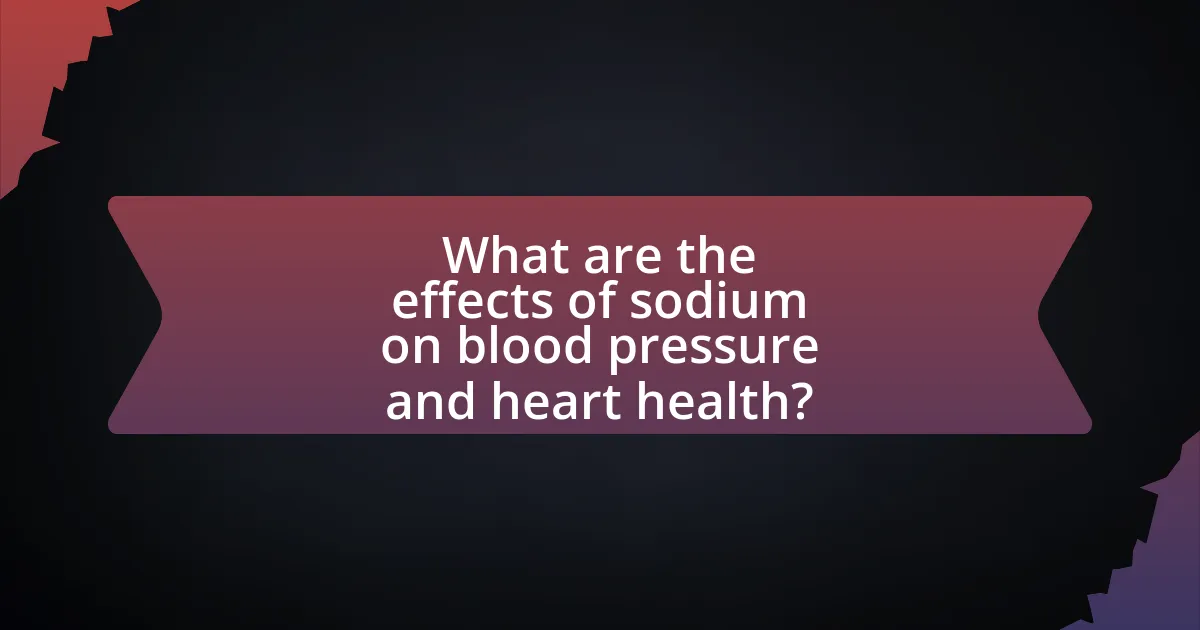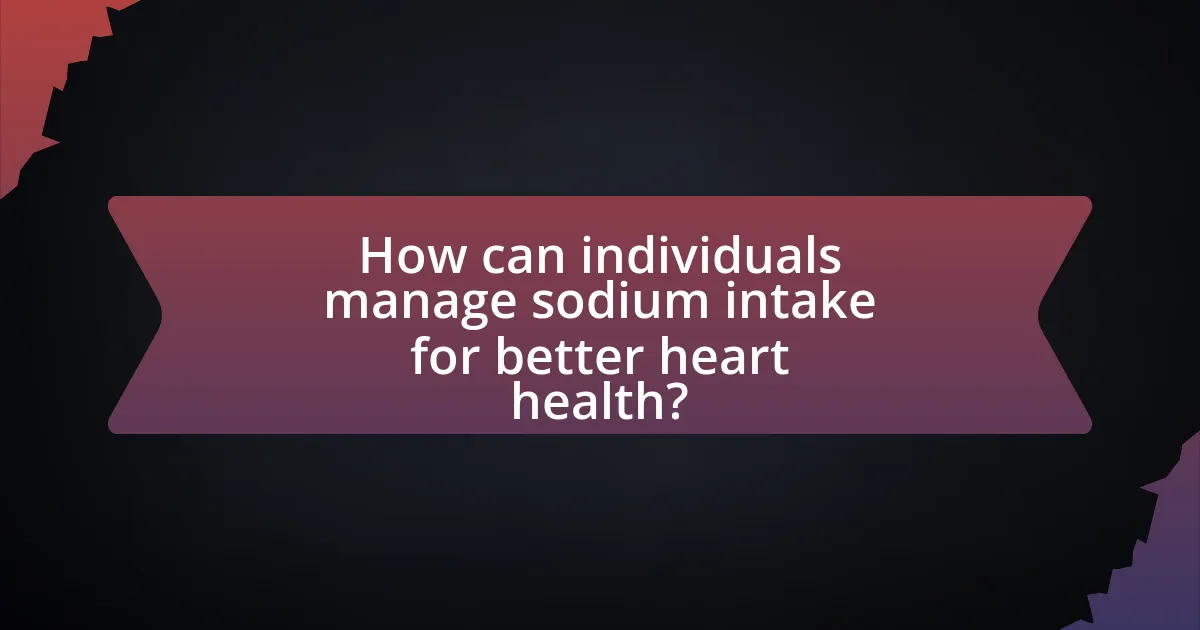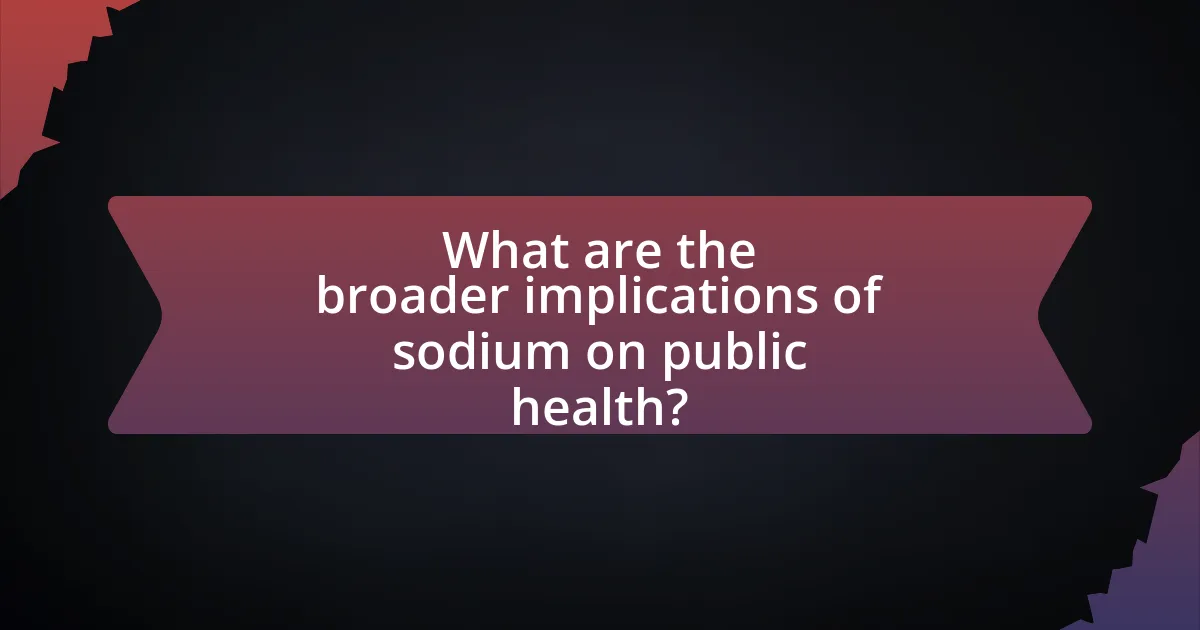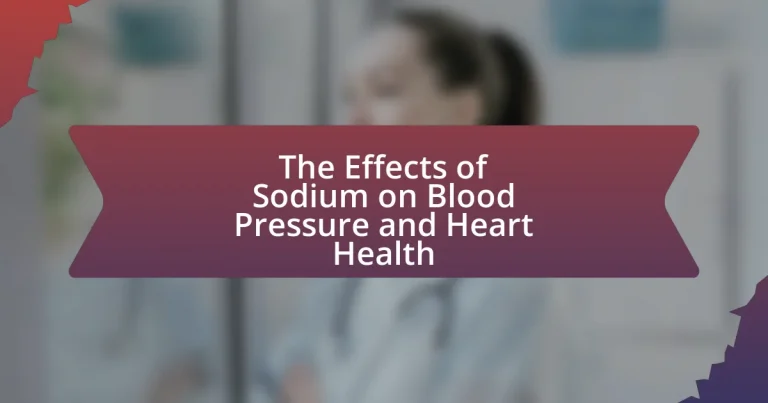Sodium intake plays a crucial role in influencing blood pressure and heart health, primarily by causing water retention that increases blood volume and pressure. High sodium consumption is linked to hypertension, a significant risk factor for cardiovascular diseases, with studies indicating that reducing sodium intake can lower blood pressure and decrease heart disease risk. The article explores the mechanisms by which sodium affects blood pressure, the recommended intake levels for heart health, dietary changes to manage sodium consumption, and the broader public health implications of high sodium diets. It emphasizes the importance of monitoring sodium intake and provides practical strategies for individuals to reduce their sodium consumption effectively.

What are the effects of sodium on blood pressure and heart health?
Sodium intake significantly affects blood pressure and heart health, primarily by causing the body to retain water, which increases blood volume and, consequently, blood pressure. High sodium consumption is linked to hypertension, a major risk factor for cardiovascular diseases. Studies, such as those published in the Journal of the American College of Cardiology, indicate that reducing sodium intake can lower blood pressure levels and decrease the risk of heart disease. Specifically, a meta-analysis found that a reduction of 2,300 mg of sodium per day can lead to a decrease in systolic blood pressure by approximately 5-6 mmHg in hypertensive individuals. Thus, managing sodium intake is crucial for maintaining optimal blood pressure and promoting heart health.
How does sodium intake influence blood pressure levels?
Sodium intake directly influences blood pressure levels by causing the body to retain water, which increases blood volume and subsequently raises blood pressure. Research indicates that high sodium consumption is linked to hypertension, with studies showing that reducing sodium intake can lead to significant decreases in blood pressure. For instance, a meta-analysis published in the American Journal of Hypertension found that a reduction of sodium intake by 2,300 mg per day can lower systolic blood pressure by approximately 5-6 mmHg in individuals with hypertension. This relationship underscores the importance of managing sodium intake for maintaining healthy blood pressure levels.
What mechanisms link sodium consumption to hypertension?
Sodium consumption is linked to hypertension primarily through its effect on fluid balance and vascular resistance. High sodium intake leads to increased extracellular fluid volume, which raises blood pressure by increasing the workload on the heart and the pressure within blood vessels. Additionally, sodium can cause the smooth muscle cells in blood vessels to constrict, further elevating blood pressure. Research indicates that populations with high sodium diets exhibit a higher prevalence of hypertension, supporting the connection between sodium intake and elevated blood pressure levels.
How does sodium affect vascular resistance and fluid balance?
Sodium increases vascular resistance and influences fluid balance by promoting water retention and affecting blood vessel constriction. Elevated sodium levels lead to increased extracellular fluid volume, which raises blood pressure and enhances vascular resistance due to the greater volume exerting pressure on vessel walls. Studies have shown that high sodium intake correlates with hypertension, as evidenced by research published in the Journal of the American College of Cardiology, which found that reducing sodium intake can lower blood pressure in hypertensive individuals. This relationship underscores the critical role sodium plays in regulating both vascular resistance and fluid balance in the body.
Why is sodium considered a risk factor for heart disease?
Sodium is considered a risk factor for heart disease because high sodium intake can lead to elevated blood pressure, a significant contributor to cardiovascular issues. When sodium levels increase, the body retains more water to dilute the sodium, which raises blood volume and, consequently, blood pressure. According to the American Heart Association, a reduction in sodium intake can lower blood pressure and reduce the risk of heart disease. Studies indicate that populations with high sodium consumption often experience higher rates of hypertension and related heart conditions, reinforcing the link between sodium and heart health.
What role does sodium play in the development of cardiovascular conditions?
Sodium plays a significant role in the development of cardiovascular conditions by contributing to elevated blood pressure, which is a major risk factor for heart disease and stroke. High sodium intake leads to increased fluid retention in the body, resulting in higher blood volume and subsequently increased pressure on blood vessel walls. Studies indicate that populations with high sodium consumption often exhibit higher rates of hypertension, with research showing that reducing sodium intake can lower blood pressure levels by an average of 5 to 6 mmHg in hypertensive individuals. This relationship underscores the importance of managing sodium intake to mitigate cardiovascular risks.
How does excessive sodium intake impact heart function?
Excessive sodium intake negatively impacts heart function by increasing blood pressure, which can lead to hypertension and cardiovascular diseases. High sodium levels cause the body to retain water, increasing blood volume and putting additional strain on the heart. Studies show that a sodium intake exceeding 2,300 milligrams per day is associated with a 30% higher risk of developing heart disease. This correlation is supported by research published in the Journal of the American College of Cardiology, which highlights that reducing sodium intake can significantly lower blood pressure and improve heart health outcomes.
What are the recommended sodium intake levels for heart health?
The recommended sodium intake level for heart health is less than 2,300 milligrams per day, with an ideal limit of 1,500 milligrams for most adults, particularly those with high blood pressure or at risk for heart disease. This recommendation is supported by the American Heart Association, which states that reducing sodium intake can help lower blood pressure and reduce the risk of cardiovascular disease. Studies have shown that high sodium consumption is linked to increased blood pressure, which is a significant risk factor for heart disease.
How do dietary guidelines vary by age and health status?
Dietary guidelines vary significantly by age and health status, reflecting the unique nutritional needs of different populations. For instance, children require higher proportions of certain nutrients for growth, while older adults often need fewer calories but more nutrients like calcium and vitamin D to maintain bone health. Additionally, individuals with specific health conditions, such as hypertension, are advised to limit sodium intake to manage blood pressure effectively; the American Heart Association recommends a sodium limit of 1,500 mg per day for those with high blood pressure. These tailored guidelines ensure that dietary recommendations address the physiological changes and health risks associated with different life stages and medical conditions.
What are the consequences of exceeding recommended sodium levels?
Exceeding recommended sodium levels can lead to increased blood pressure and heightened risk of cardiovascular diseases. High sodium intake causes the body to retain water, which increases blood volume and, consequently, blood pressure. According to the American Heart Association, consuming more than 2,300 milligrams of sodium per day can elevate the risk of hypertension, heart attack, and stroke. Studies indicate that a reduction in sodium intake can lower blood pressure, demonstrating a direct correlation between sodium levels and heart health.

How can individuals manage sodium intake for better heart health?
Individuals can manage sodium intake for better heart health by adhering to a daily limit of 2,300 milligrams or less, as recommended by the American Heart Association. Reducing sodium intake can lower blood pressure, which is crucial for heart health; studies show that a decrease in sodium can lead to a significant reduction in hypertension-related risks. Additionally, individuals can achieve this by choosing fresh foods over processed ones, reading nutrition labels to monitor sodium content, and using herbs and spices for flavor instead of salt. These strategies collectively contribute to improved cardiovascular health and reduced risk of heart disease.
What dietary changes can help reduce sodium consumption?
To reduce sodium consumption, individuals should focus on consuming fresh, whole foods while minimizing processed and packaged foods. Fresh fruits, vegetables, whole grains, and lean proteins typically contain lower sodium levels compared to processed foods, which often have added salt for preservation and flavor. According to the Centers for Disease Control and Prevention (CDC), about 70% of sodium intake comes from processed foods, highlighting the importance of dietary choices in managing sodium levels. Additionally, using herbs and spices instead of salt for seasoning can further decrease sodium intake while enhancing flavor.
Which foods are high in sodium and should be limited?
Foods high in sodium that should be limited include processed meats, canned soups, snack foods, and certain condiments. Processed meats like bacon and deli meats often contain high levels of sodium for preservation and flavor enhancement, with some products exceeding 1,000 mg of sodium per serving. Canned soups can also be high in sodium, with many varieties containing over 800 mg per serving. Snack foods such as chips and pretzels frequently have added salt, contributing to high sodium intake. Additionally, condiments like soy sauce and ketchup can contain significant amounts of sodium, with soy sauce having around 1,000 mg per tablespoon. Limiting these foods can help manage blood pressure and improve heart health.
How can meal preparation techniques lower sodium levels?
Meal preparation techniques can lower sodium levels by allowing individuals to control the amount of salt added to their meals. By using methods such as cooking from scratch, individuals can avoid the high sodium content found in processed foods and restaurant meals, which often contain excessive salt for flavor enhancement. Research indicates that home-cooked meals typically have 50-75% less sodium compared to pre-packaged options, significantly reducing overall sodium intake. Additionally, incorporating herbs, spices, and citrus as flavor alternatives can further minimize the need for added salt, promoting healthier eating habits and better heart health.
What are the benefits of monitoring sodium intake?
Monitoring sodium intake helps manage blood pressure and reduce the risk of heart disease. High sodium consumption is linked to hypertension, which affects approximately 1 in 3 adults in the United States, according to the American Heart Association. By keeping sodium levels in check, individuals can lower their blood pressure, leading to a decreased likelihood of cardiovascular events such as heart attacks and strokes. Additionally, monitoring sodium intake can improve overall heart health by promoting better fluid balance and reducing strain on the heart.
How does tracking sodium consumption affect blood pressure management?
Tracking sodium consumption significantly aids in blood pressure management by allowing individuals to monitor and reduce their intake, which is directly linked to hypertension. High sodium intake can lead to increased blood volume and elevated blood pressure, as evidenced by studies indicating that reducing sodium intake by 1,000 mg per day can lower blood pressure by approximately 5-6 mm Hg in hypertensive individuals. This correlation underscores the importance of tracking sodium to maintain optimal blood pressure levels and improve overall heart health.
What tools or apps can assist in sodium tracking?
Several tools and apps can assist in sodium tracking, including MyFitnessPal, Cronometer, and Lose It!. MyFitnessPal allows users to log food intake and provides detailed nutritional information, including sodium content, which helps individuals monitor their sodium consumption effectively. Cronometer offers a comprehensive nutrient tracking system that emphasizes micronutrients, including sodium, making it suitable for those focused on detailed dietary management. Lose It! also features a user-friendly interface for tracking food and sodium intake, promoting awareness of sodium levels in daily diets. These apps are widely recognized for their effectiveness in helping users manage sodium intake, which is crucial for maintaining healthy blood pressure and heart health.

What are the broader implications of sodium on public health?
Sodium has significant broader implications on public health, primarily through its role in increasing blood pressure and contributing to cardiovascular diseases. High sodium intake is linked to hypertension, which affects approximately 1.13 billion people globally, according to the World Health Organization. Elevated blood pressure is a major risk factor for heart disease and stroke, leading to millions of deaths each year. Furthermore, excessive sodium consumption is often associated with processed foods, which can exacerbate health disparities in populations with limited access to fresh foods. Reducing sodium intake is a public health priority, as evidenced by initiatives like the CDC’s Sodium Reduction Initiative, aimed at lowering sodium consumption to improve overall health outcomes.
How does sodium consumption vary across different populations?
Sodium consumption varies significantly across different populations due to dietary habits, cultural practices, and socioeconomic factors. For instance, populations in countries like Japan and South Korea typically consume higher sodium levels, averaging around 10-12 grams per day, largely due to the prevalence of fermented foods and soy sauce in their diets. In contrast, populations in the United States and many European countries consume lower sodium levels, averaging about 3-4 grams per day, influenced by increased awareness of health risks associated with high sodium intake. Studies, such as those published in the American Journal of Hypertension, indicate that these variations in sodium consumption directly correlate with differences in hypertension prevalence and cardiovascular health outcomes among these populations.
What factors contribute to high sodium intake in certain demographics?
High sodium intake in certain demographics is primarily influenced by dietary habits, socioeconomic status, and cultural food preferences. Many individuals in lower socioeconomic groups often rely on processed and convenience foods, which are typically high in sodium due to preservation and flavor enhancement. Additionally, cultural cuisines may emphasize salty flavors, leading to higher sodium consumption. For instance, studies indicate that populations with diets rich in processed foods can exceed the recommended sodium intake of 2,300 mg per day, contributing to health issues such as hypertension and cardiovascular disease.
How can public health initiatives address sodium reduction?
Public health initiatives can address sodium reduction by implementing policies that promote lower sodium intake among populations. These initiatives can include educational campaigns that raise awareness about the health risks associated with high sodium consumption, such as hypertension and cardiovascular diseases. For instance, the Centers for Disease Control and Prevention (CDC) has reported that reducing sodium intake can significantly lower blood pressure and decrease the risk of heart disease. Additionally, public health strategies may involve working with food manufacturers to reformulate products to contain less sodium, as well as encouraging restaurants to offer lower-sodium options. Evidence from the World Health Organization indicates that such comprehensive approaches can lead to a measurable decrease in population-wide sodium intake, ultimately improving public health outcomes.
What are the long-term health outcomes associated with high sodium diets?
High sodium diets are associated with increased long-term health risks, particularly hypertension, cardiovascular disease, and stroke. Research indicates that excessive sodium intake raises blood pressure, which is a significant risk factor for heart disease and stroke. A study published in the Journal of the American College of Cardiology found that individuals consuming more than 2,300 mg of sodium daily had a 50% higher risk of developing hypertension compared to those with lower intake levels. Additionally, the World Health Organization links high sodium consumption to increased mortality rates from cardiovascular diseases, emphasizing the importance of sodium reduction for long-term health.
How does sodium intake correlate with rates of hypertension and heart disease in populations?
Sodium intake is positively correlated with increased rates of hypertension and heart disease in populations. High sodium consumption leads to elevated blood pressure, which is a significant risk factor for cardiovascular diseases. Studies, such as those published in the American Journal of Hypertension, indicate that populations with higher sodium intake, often exceeding 2,300 mg per day, experience higher incidences of hypertension. Furthermore, the World Health Organization reports that reducing sodium intake can lower blood pressure and subsequently decrease the risk of heart disease and stroke. This evidence underscores the critical relationship between sodium consumption and cardiovascular health outcomes.
What strategies can be implemented to educate the public about sodium risks?
To educate the public about sodium risks, implementing community-based educational programs is essential. These programs can include workshops, seminars, and cooking classes that focus on the health impacts of high sodium intake, particularly its link to hypertension and cardiovascular diseases. Research indicates that reducing sodium intake can lower blood pressure, with a meta-analysis showing that a decrease of 2.5 grams per day can reduce systolic blood pressure by approximately 5 mmHg in adults. Additionally, utilizing social media campaigns and informational materials, such as brochures and infographics, can effectively disseminate knowledge about sodium content in common foods and the importance of reading nutrition labels. Collaborating with healthcare providers to promote regular screenings for blood pressure can further reinforce the message about sodium risks and encourage healthier dietary choices.
What practical tips can help individuals reduce sodium intake effectively?
To effectively reduce sodium intake, individuals should focus on cooking with fresh ingredients and using herbs and spices instead of salt. This approach not only enhances flavor but also significantly lowers sodium consumption. According to the Centers for Disease Control and Prevention (CDC), reducing sodium intake to less than 2,300 milligrams per day can lower blood pressure and improve heart health. Additionally, individuals should read food labels to identify high-sodium products, choose low-sodium or no-salt-added options, and limit processed foods, which often contain excessive sodium. These strategies collectively contribute to better management of blood pressure and overall cardiovascular health.
How can reading food labels assist in making healthier choices?
Reading food labels assists in making healthier choices by providing essential information about the nutritional content of food products, particularly sodium levels. By examining these labels, individuals can identify foods that are high in sodium, which is linked to increased blood pressure and heart health risks. For instance, the American Heart Association recommends limiting sodium intake to less than 2,300 milligrams per day to maintain optimal cardiovascular health. Therefore, understanding food labels enables consumers to select lower-sodium options, ultimately contributing to better health outcomes.
What are some easy swaps for high-sodium ingredients in recipes?
Easy swaps for high-sodium ingredients in recipes include using fresh herbs instead of salt, opting for low-sodium broth instead of regular broth, and substituting lemon juice or vinegar for soy sauce. Fresh herbs like basil or cilantro can enhance flavor without adding sodium, while low-sodium broth reduces overall salt intake significantly. Additionally, lemon juice or vinegar can provide a tangy flavor that mimics the umami taste of soy sauce, allowing for a healthier alternative. These substitutions help maintain flavor while supporting heart health by reducing sodium consumption, which is linked to lower blood pressure levels.





